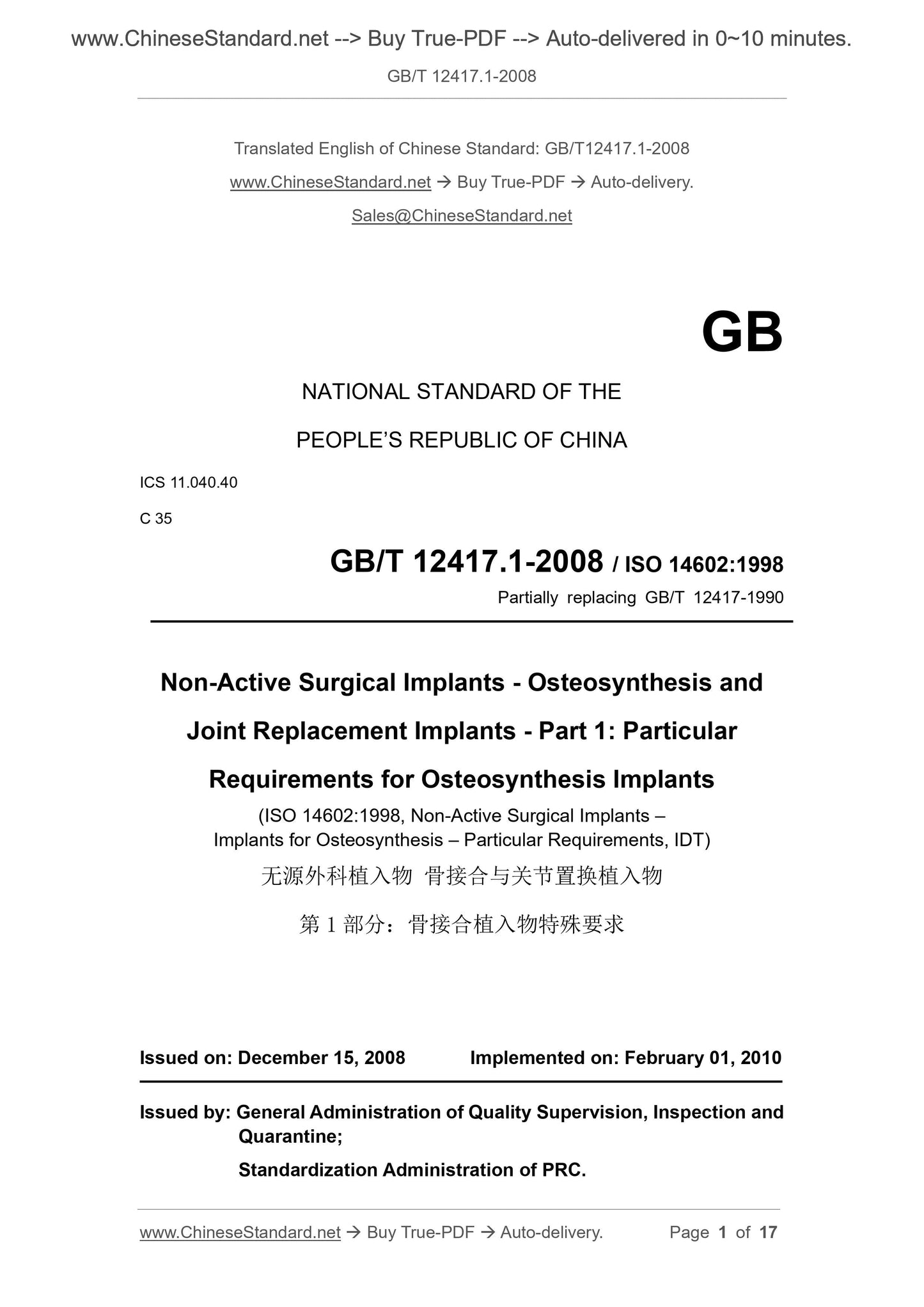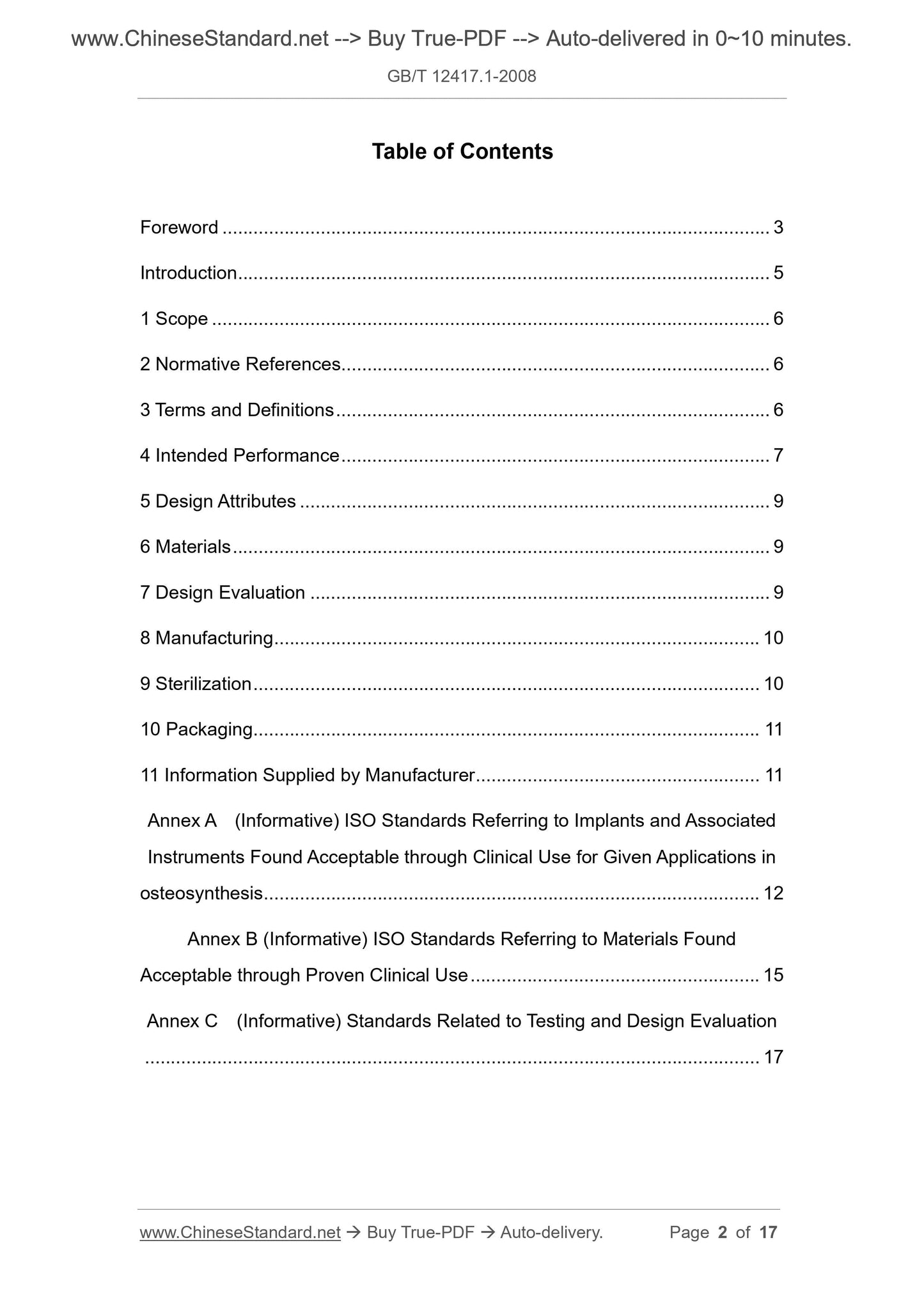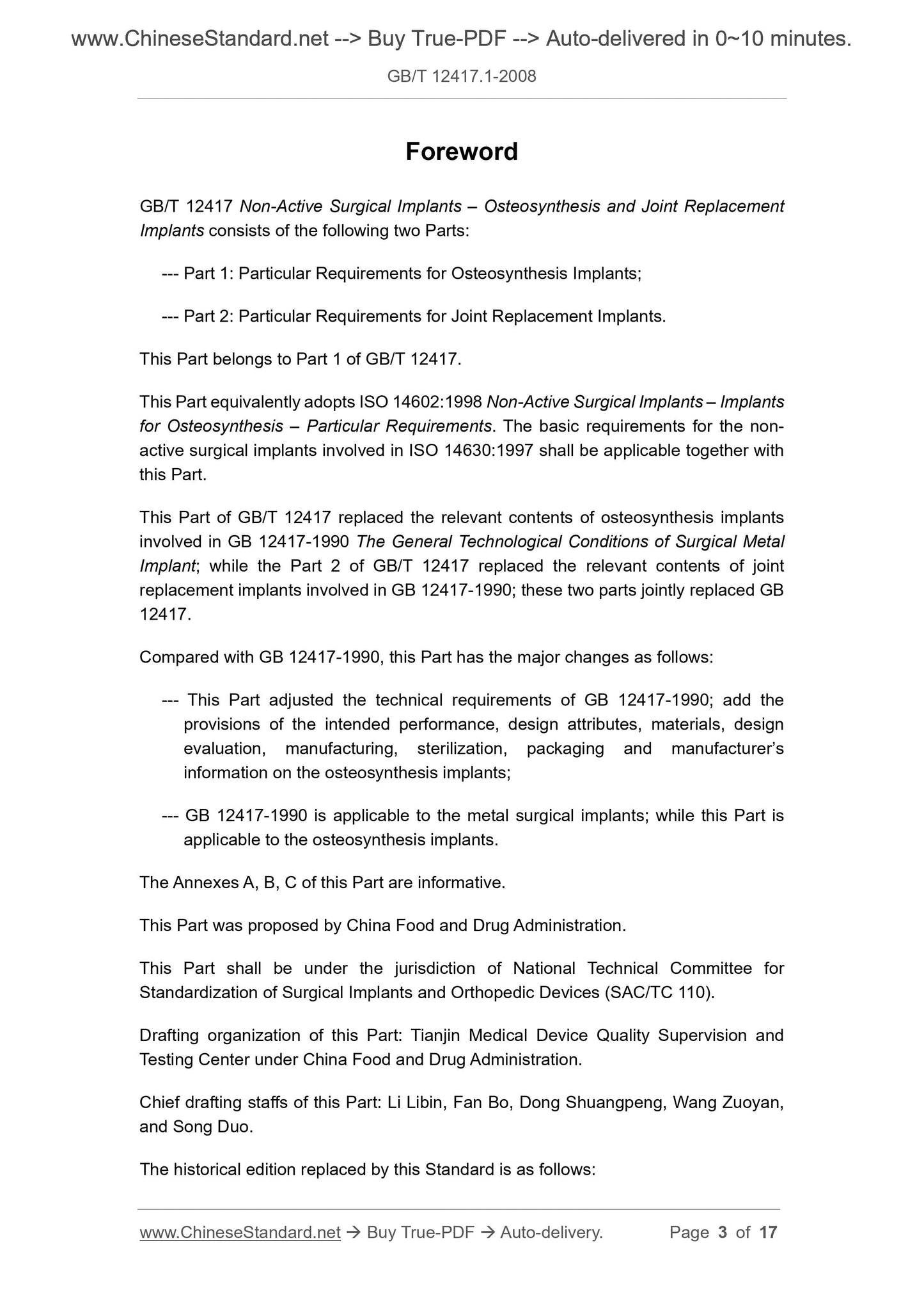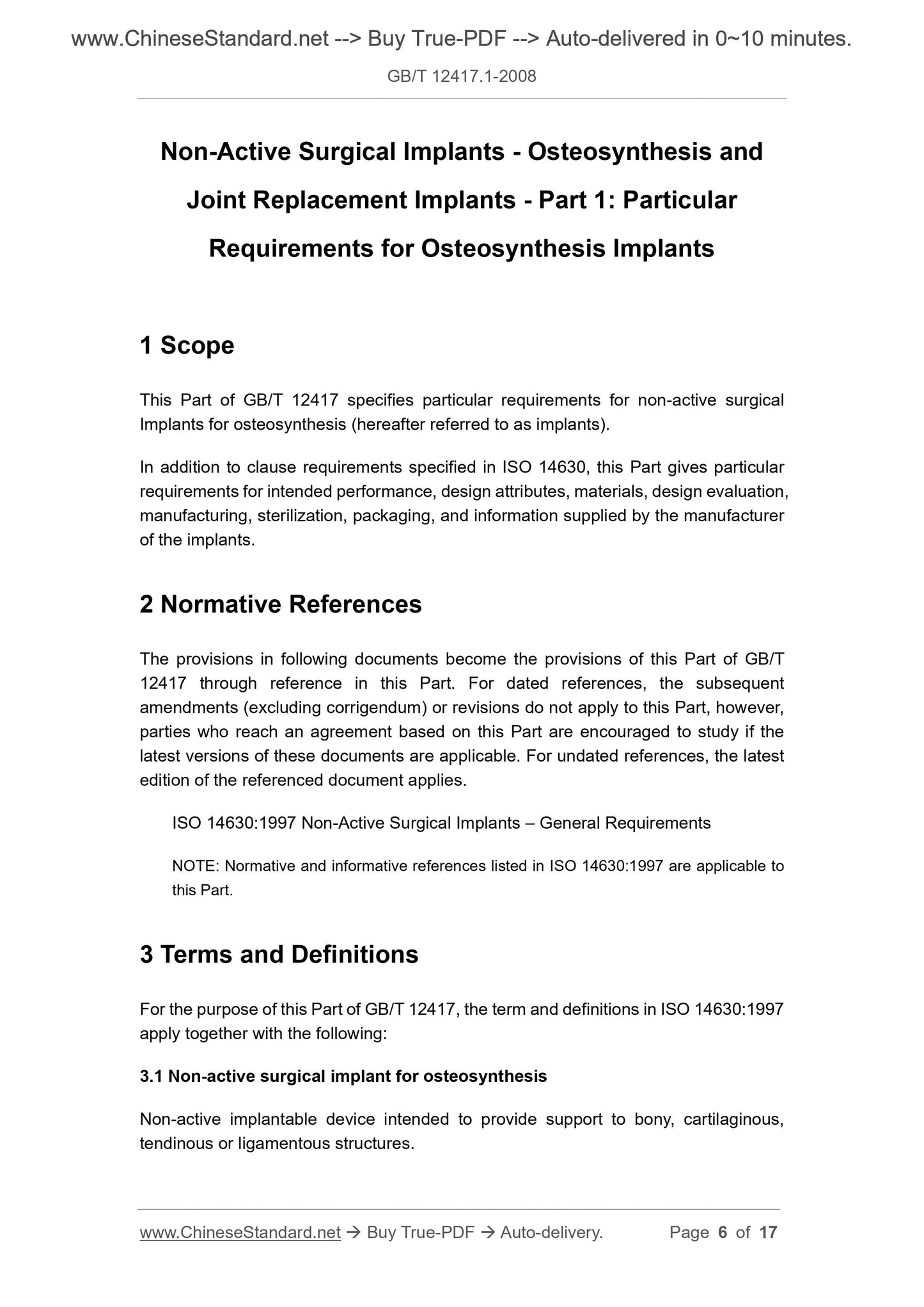1
/
von
4
PayPal, credit cards. Download editable-PDF and invoice in 1 second!
GB/T 12417.1-2008 English PDF (GBT12417.1-2008)
GB/T 12417.1-2008 English PDF (GBT12417.1-2008)
Normaler Preis
$130.00 USD
Normaler Preis
Verkaufspreis
$130.00 USD
Grundpreis
/
pro
Versand wird beim Checkout berechnet
Verfügbarkeit für Abholungen konnte nicht geladen werden
Delivery: 3 seconds. Download true-PDF + Invoice.
Get QUOTATION in 1-minute: Click GB/T 12417.1-2008
Historical versions: GB/T 12417.1-2008
Preview True-PDF (Reload/Scroll if blank)
GB/T 12417.1-2008: Non-active surgical implants -- Osteosynthesis and joint replacement implants -- Part 1: Particular requirements for osteosynthesis implants
GB/T 12417.1-2008
Non-active surgical implants.Osteosynthesis and joint replacement implants.Part 1. Particular requirements for osteosynthesis implants
ICS 11.040.40
C35
National Standards of People's Republic of China
GB/T 12417.1-2008/ISO 14602.1998
Partially replace GB 12417-1990
Passive surgical implant
Bone joint and joint replacement implant
Part 1. Special requirements for osteosynthesis implants
(ISO 14602.1998, Non-activesurgicalimplants-
Implantsforosteosynthesis-Particularrequirements, IDT)
2008-12-15 released.2010-02-01 implementation
General Administration of Quality Supervision, Inspection and Quarantine of the People's Republic of China
China National Standardization Administration issued
Foreword
GB/T 12417 "Passive Surgical Implants and Joint Replacement Implants" is divided into two parts.
--- Part 1. Special requirements for osteosynthesis implants;
--- Part 2. Special requirements for joint replacement implants.
This part is the first part of GB/T 12417.
This section is equivalent to ISO 14602.1998 "Special requirements for passive surgical implant bone-engaged implants". for
The basic requirements for passive surgical implants covered by ISO 14630.1997 shall apply in conjunction with this section.
This part of GB/T 12417 replaces GB 12417-1990 "General Technical Conditions for Surgical Metal Implants" for bone-engagement implants
The content of the object, the second part of GB/T 12417 replaces the content of the joint replacement implant in GB 12417-1990, the two parts are common
Complete the replacement of GB 12417.
The main changes in this section compared with GB 12417-1990 are as follows.
--- This section adjusts the technical requirements of GB 12417-1990, increasing the expected performance and design of bone-engaged implants.
Provisions for information provided by attributes, materials, design evaluation, manufacturing, sterilization, packaging, and manufacturers;
--- GB 12417-1990 standard for metal surgical implants, this section applies to bone-engaged implants.
Appendix A, Appendix B and Appendix C of this part are informative annexes.
This part is proposed by the State Food and Drug Administration.
This part is under the jurisdiction of the National Technical Committee for Standardization of Surgical Implants and Orthopedic Devices (SAC/TC110).
This section drafted by. State Food and Drug Administration Tianjin Medical Device Quality Supervision and Inspection Center.
The main drafters of this section. Li Libin, Fan Platinum, Dong Shuangpeng, Wang Wei, Song Wei.
The previous versions of the standards replaced by this section are.
---GB 12417-1990.
GB/T 12417.1-2008/ISO 14602.1998
introduction
Passive surgical bone-engagement implants for wound healing or orthopedic surgery with the goal of stabilizing the fractured bone and its structure to achieve healing of the bone
Or a fusion effect, and/or provide support and correction functions. When the intended function is completed, the implant can be removed or left in the body.
The standards for passive surgical implants and related instruments are divided into three grades. The standard levels related to the implant itself are as follows
(The first level standard is the highest).
--- Level 1. General requirements for passive surgical implants;
--- Level 2. special requirements for all types of passive surgical implants;
--- Level 3. Special requirements for various passive surgical implants.
This part of GB/T 12417 is a secondary standard that covers the requirements for use in bone-engaged implants in passive surgical implants.
The primary standard includes requirements that apply to all passive surgical implants. It also states that some additional requirements are included in the second and third levels.
In the standard.
As a first-class standard ISO 14630.1997 has been released, see YY/T 0640-2008 "General requirements for passive surgical implants
Seeking" (ISO 14630.2005, IDT).
The tertiary standard applies to specific implants in certain types of implants, such as the knee and hip joints.
If all requirements are involved, it is recommended to start the search from the current minimum level standard.
Related references can also be found in the appendix to this section.
GB/T 12417.1-2008/ISO 14602.1998
Passive surgical implant
Bone joint and joint replacement implant
Part 1. Special requirements for osteosynthesis implants
1 range
This part of GB/T 12417 specifies the special requirements for passive surgical implants for bone joining (hereinafter referred to as implants).
In addition to the provisions of the ISO 14630 provisions, this section on the expected performance of the implant, design properties, materials, design evaluation, manufacturing, extinction
The information provided by the bacteria, packaging and manufacturer has made special requirements.
2 Normative references
The terms of the following documents become the provisions of this part by reference in this part of GB/T 12417. Quotations with dated
And all subsequent amendments (not including errata content) or revisions do not apply to this section, however, encouragement is achieved in accordance with this section.
The parties to the agreement study whether the latest versions of these documents can be used. For undated references, the latest edition applies to this
section.
ISO 14630.1997 General requirements for passive surgical implants
Note. Normative or informative references in ISO 14630.1997 apply to this section.
3 Terms and definitions
The following terms and definitions established in ISO 14630.1997 apply to this part of GB/T 12417.
3.1
A passive surgical implant for supporting bone, cartilage, tendon or ligament structures.
4 expected performance
The expected performance should meet the requirements of Chapter 4 of ISO 14630.1997, and the following requirements should be considered.
Note. Because of the diversity of anatomy, fracture site and application, bone-joined implants should have certain versatility; the size of the implant should also be anatomically
There are certain limitations; bone, bone structure and other defects may also affect the performance of the implant.
4.1 Functional characteristics
In describing the expected performance of the implant, the following items should be given where applicable.
a) the type of tissue fixed to bone, cartilage, tendon or ligament;
b) the manner of attachment or fixation to the bone;
c) the connection between the implant component and the bone or other tissue structure;
d) the use of the repair process;
e) Can it be taken out;
f) role in bone or adjacent tissue structure, for example.
---stable;
---Limit or control movement;
--- Prevent deformation of fractures and dislocation of bone or other structural tissues;
---Connect the debris;
GB/T 12417.1-2008/ISO 14602.1998
---Control extrusion or transfer;
--- Protection against adjacent tissue structures.
4.2 Typical clinical application
When describing the expected performance of the implant, the range of expected typical applications should be given, for example.
a) fracture treatment;
b) tumor treatment;
c) the stability of the osteotomy;
d) stability of arthrodesis;
e) bone extension, shortening or connection;
f) support for bone replacement (bone graft);
g) attachments for joint replacement;
h) scoliosis treatment;
i) spinal fixation;
j) treatment of degenerative diseases;
k) reconstruction of tendons;
l) Reconstruction of the ligament.
Note. The anatomical location should...
Get QUOTATION in 1-minute: Click GB/T 12417.1-2008
Historical versions: GB/T 12417.1-2008
Preview True-PDF (Reload/Scroll if blank)
GB/T 12417.1-2008: Non-active surgical implants -- Osteosynthesis and joint replacement implants -- Part 1: Particular requirements for osteosynthesis implants
GB/T 12417.1-2008
Non-active surgical implants.Osteosynthesis and joint replacement implants.Part 1. Particular requirements for osteosynthesis implants
ICS 11.040.40
C35
National Standards of People's Republic of China
GB/T 12417.1-2008/ISO 14602.1998
Partially replace GB 12417-1990
Passive surgical implant
Bone joint and joint replacement implant
Part 1. Special requirements for osteosynthesis implants
(ISO 14602.1998, Non-activesurgicalimplants-
Implantsforosteosynthesis-Particularrequirements, IDT)
2008-12-15 released.2010-02-01 implementation
General Administration of Quality Supervision, Inspection and Quarantine of the People's Republic of China
China National Standardization Administration issued
Foreword
GB/T 12417 "Passive Surgical Implants and Joint Replacement Implants" is divided into two parts.
--- Part 1. Special requirements for osteosynthesis implants;
--- Part 2. Special requirements for joint replacement implants.
This part is the first part of GB/T 12417.
This section is equivalent to ISO 14602.1998 "Special requirements for passive surgical implant bone-engaged implants". for
The basic requirements for passive surgical implants covered by ISO 14630.1997 shall apply in conjunction with this section.
This part of GB/T 12417 replaces GB 12417-1990 "General Technical Conditions for Surgical Metal Implants" for bone-engagement implants
The content of the object, the second part of GB/T 12417 replaces the content of the joint replacement implant in GB 12417-1990, the two parts are common
Complete the replacement of GB 12417.
The main changes in this section compared with GB 12417-1990 are as follows.
--- This section adjusts the technical requirements of GB 12417-1990, increasing the expected performance and design of bone-engaged implants.
Provisions for information provided by attributes, materials, design evaluation, manufacturing, sterilization, packaging, and manufacturers;
--- GB 12417-1990 standard for metal surgical implants, this section applies to bone-engaged implants.
Appendix A, Appendix B and Appendix C of this part are informative annexes.
This part is proposed by the State Food and Drug Administration.
This part is under the jurisdiction of the National Technical Committee for Standardization of Surgical Implants and Orthopedic Devices (SAC/TC110).
This section drafted by. State Food and Drug Administration Tianjin Medical Device Quality Supervision and Inspection Center.
The main drafters of this section. Li Libin, Fan Platinum, Dong Shuangpeng, Wang Wei, Song Wei.
The previous versions of the standards replaced by this section are.
---GB 12417-1990.
GB/T 12417.1-2008/ISO 14602.1998
introduction
Passive surgical bone-engagement implants for wound healing or orthopedic surgery with the goal of stabilizing the fractured bone and its structure to achieve healing of the bone
Or a fusion effect, and/or provide support and correction functions. When the intended function is completed, the implant can be removed or left in the body.
The standards for passive surgical implants and related instruments are divided into three grades. The standard levels related to the implant itself are as follows
(The first level standard is the highest).
--- Level 1. General requirements for passive surgical implants;
--- Level 2. special requirements for all types of passive surgical implants;
--- Level 3. Special requirements for various passive surgical implants.
This part of GB/T 12417 is a secondary standard that covers the requirements for use in bone-engaged implants in passive surgical implants.
The primary standard includes requirements that apply to all passive surgical implants. It also states that some additional requirements are included in the second and third levels.
In the standard.
As a first-class standard ISO 14630.1997 has been released, see YY/T 0640-2008 "General requirements for passive surgical implants
Seeking" (ISO 14630.2005, IDT).
The tertiary standard applies to specific implants in certain types of implants, such as the knee and hip joints.
If all requirements are involved, it is recommended to start the search from the current minimum level standard.
Related references can also be found in the appendix to this section.
GB/T 12417.1-2008/ISO 14602.1998
Passive surgical implant
Bone joint and joint replacement implant
Part 1. Special requirements for osteosynthesis implants
1 range
This part of GB/T 12417 specifies the special requirements for passive surgical implants for bone joining (hereinafter referred to as implants).
In addition to the provisions of the ISO 14630 provisions, this section on the expected performance of the implant, design properties, materials, design evaluation, manufacturing, extinction
The information provided by the bacteria, packaging and manufacturer has made special requirements.
2 Normative references
The terms of the following documents become the provisions of this part by reference in this part of GB/T 12417. Quotations with dated
And all subsequent amendments (not including errata content) or revisions do not apply to this section, however, encouragement is achieved in accordance with this section.
The parties to the agreement study whether the latest versions of these documents can be used. For undated references, the latest edition applies to this
section.
ISO 14630.1997 General requirements for passive surgical implants
Note. Normative or informative references in ISO 14630.1997 apply to this section.
3 Terms and definitions
The following terms and definitions established in ISO 14630.1997 apply to this part of GB/T 12417.
3.1
A passive surgical implant for supporting bone, cartilage, tendon or ligament structures.
4 expected performance
The expected performance should meet the requirements of Chapter 4 of ISO 14630.1997, and the following requirements should be considered.
Note. Because of the diversity of anatomy, fracture site and application, bone-joined implants should have certain versatility; the size of the implant should also be anatomically
There are certain limitations; bone, bone structure and other defects may also affect the performance of the implant.
4.1 Functional characteristics
In describing the expected performance of the implant, the following items should be given where applicable.
a) the type of tissue fixed to bone, cartilage, tendon or ligament;
b) the manner of attachment or fixation to the bone;
c) the connection between the implant component and the bone or other tissue structure;
d) the use of the repair process;
e) Can it be taken out;
f) role in bone or adjacent tissue structure, for example.
---stable;
---Limit or control movement;
--- Prevent deformation of fractures and dislocation of bone or other structural tissues;
---Connect the debris;
GB/T 12417.1-2008/ISO 14602.1998
---Control extrusion or transfer;
--- Protection against adjacent tissue structures.
4.2 Typical clinical application
When describing the expected performance of the implant, the range of expected typical applications should be given, for example.
a) fracture treatment;
b) tumor treatment;
c) the stability of the osteotomy;
d) stability of arthrodesis;
e) bone extension, shortening or connection;
f) support for bone replacement (bone graft);
g) attachments for joint replacement;
h) scoliosis treatment;
i) spinal fixation;
j) treatment of degenerative diseases;
k) reconstruction of tendons;
l) Reconstruction of the ligament.
Note. The anatomical location should...
Share








